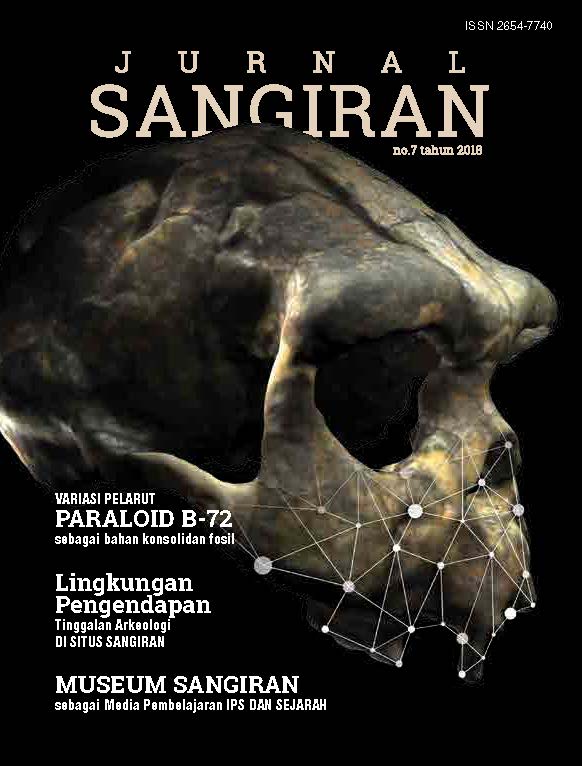Abstrak
Situs Banjarejo sekali lagi membuktikan potensi paleontologis dengan ditemukan
himpunan fosil gajah purba yang relatif lengkap. Mengingat temuan tersebut sangat
penting, maka Balai Pelestarian Situs Manusia Purba Sangiran melalukan penyelamat
temuan. Tujuan penyelamatan adalah untuk mengetahui jenis temuan, konteks stratigrafi
temuan, dan lingkungan pengendapan temuan. Untuk mencapai tujuan diperlukan metode
penelitian dengan survei geologi dan ekskavasi. Survei permukaan dikhususkan pada
survei geologi terhadap singkapan-singkapan lapisan tanah di sekitar lokasi penemuan.
Ekskavasi penyelamatan dilakukan dengan memperluas kotak penggalian berukuran 14
meter x 14 meter.
Ekskavasi penyelamatan oleh Balai Pelestarian Situs Manusia Purba Sangiran telah
menemukan dan mendata lebih dari 872 fragmen fosil dan atau fosil. Hampir 80% temuan
merupakan bagian dari ordo Proboscidae. Salah satu temuan berupa fragmen molar
inferior (gigi geraham) Elephas sp. Kemungkinan besar temuan dari ordo Proboscidae
menunjuk pada Elephas sp., karena bagian gigi merupakan salah satu indikator kuat untuk
mengetahui jenis binatang sampai tingkatan terendah. Konteks stratigrafi temuan fosil
gajah purba, berasal dari lapisan konglomerat pasir dan lempung karbonatan. Lapisan
tersebut mengindikasikan bahwa lingkungan pengendapan berupa lingkungan pantai, atau
lingkungan darat dekat zona garis pantai berdampingan dengan daerah padang rumput
dan hutan terbuka. Perkiraan usia relatif temuan berdasarkan jenis fauna dan konteks
stratigrafi dari Plestosen bawah – Plestosen Tengah.
Temuan tersebut memberikan informasi berharga terkait proses migrasi dan kolonisasi
binatang dan manusia di Pulau Jawa. Selain itu dapat dijadikan indikasi untuk mengetahui
lingkungan purba di sekitar Situs Banjarejo dan Jawa pada umumnya. Posisi Situs Banjarejo yang cenderung soliter ternyata mampu memberikan harapan baru bagi penelitian manusia, budaya dan lingkungan purba di Jawa ke depan.
Kata Kunci : Ekskavasi Penyelamatan, Kala Pleistosen, Konteks Stratigrafi, lingkungan
pengendapan, Situs Banjarejo
Abstract
Banjarejo Site shows that paleontology potential of abundant fossils of elephant. That have
complete bone components. The finding are very important, so that the Conservation office
of Sangiran Early Man Site carries out fossil rescue. The purpose of the rescue are know the type, stratigraphic context, and depositional environment. So we need a geological survey and excavation research method. Geological survey of the surface of the soil layer around the discovery site. Rescue excavations were carried out by expanding the excavation box measuring 14 meters x 14 meters.
The result of fossil excavation rescue at Conservation office of Sangiran Early Man Site
more than 872 fossil fragment or fossil. Almost 80% of the finding are the Proboscidae. The
findings of the excavation are the fragment of molar inferior Elephas sp. These findings suggest that fossil or fossil fragments of the Proboscidae are from Elephas sp. The fragment of molar becomes one of the character to know about type of animal until genus or species level. The stratigraphic context of the findings of ancient elephant fossils, comes from layers of sand conglomerates and carbonate clays. This layer shows that the depositional environment are the form of a coastal environment, or a terrestrial environment near the shoreline zone adjacent to the grassland area and forest. The relative age of the findings based on the type of fauna and the stratigraphic context of the lower Plestosen – Middle Plestosen.
The finding gives valuable information about the migration and colonization of animals
and humans in Java. It can be used as an indication to find out about the ancient environment around Banjarejo Site and Java. The position of Banjarejo Site which tends to be solitary gives new hope for human, culture and abundant environment in Java.
Keyword : Rescue Excavation, Pleistocene Period, Stratigraphic Context, depositional
environment, Banjarejo Site (Wahyu Widiyanta)
Selengkapnya, silahkan klik



